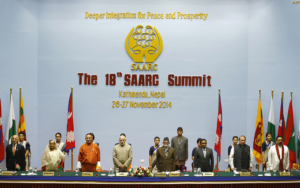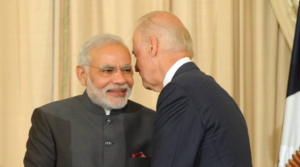At a recently held international seminar in Islamabad, I was asked to speak on the challenges to stability and prosperity in South Asia, and whether the regional states were up to the plate to address them and benefit from a myriad opportunities unleashed by globalisation.
These questions are not new. Nor is it difficult to identify the challenges and their solutions. However, one finds the region in a state of seemingly intractable dysfunctionality. Worryingly, there is not a single country in the region that is able to coalesce all the other countries around a comprehensive regional agenda that also, in a way, helps settle bilateral conflicts.
South Asia is the least integrated region in the world with intra-regional trade at around 4 percent. From travel restrictions to impediments in cultural cooperation, the South Asian picture is one of disappointment. SAARC (South Asian Association for Regional Cooperation), that was founded in 1985, is literally affected with atrophy. No wonder, its leaders have been able to meet only 18 times during the 35 years of its existence. The 19th summit meeting that was to take place in November 2016 in Islamabad, fell prey to India’s characteristic hubris and intransigence now tightly wrapped in the retrogressive worldview of ‘Hindutva.’

Regional cooperation, in general, remains elusive if bilateral relations in any given region are riven with deep mistrust and disputes. Simply put, regional cooperative frameworks cannot be built on rickety and unpredictable bilateral relations. And in the case of South Asia, hostility between India and Pakistan is the biggest barrier. Unfortunately, the two countries have failed to resolve their bilateral issues, especially the Jammu and Kashmir dispute. Their relations have been moving from a logjam to a logjam, squandering bilateral energies in breaking stalemates rather than crafting a tenable modus vivendi.
The two countries have almost exhausted all the possibilities — from fighting wars to putting together a whole raft of confidence-building measures to negotiating disputes and issues from Kashmir to terrorism through back-channel diplomacy. But instead of resolving their existing problems they have ended up adding more to the list, further complicating the bilateral relationship. All these years they have been moving one step forward to taking two steps back.
To one’s utter chagrin, the international community, by and large, remains insouciant to Indian’s genocidal policies.
And then comes the fateful day of August 5 2019. India strips Jammu and Kashmir of its special status in breach of the relevant UN Security Council resolutions, as well as its own constitution. The jingoistic India, showing no mercy to Kashmiris, imposes a complete lockdown, depriving them of even the basic facilities of mobile phone and internet to vent their outrage. The harrowing lockdown continues, with no respite in sight. To add insult to injury, New Delhi is now all out to gradually change the demographic realities of Jammu and Kashmir by encouraging and allowing Indians to settle in the illegally occupied land. Hindutva’s long-term agenda to turn the Muslim majority there into a minority is now being implemented in full swing. And to one’s utter chagrin, the international community, by and large, remains insouciant to Indian’s genocidal policies.
By taking such horrendous steps, India has yet again betrayed its predilections to compounding situations almost beyond redemption. As expected, and justifiably so, Pakistan reacted sharply to India’s brazen volte face by, among other things, downgrading diplomatic relations and halting bilateral trade. Their relations are stuck in another impasse, once again, and this time there is barely any space left for bilateral diplomacy to get bilateral engagement back on track.
The irony of the matter is that their bilateral conflict has also been regionalised, especially in the context of Afghanistan. India’s defensive-offence doctrine that seeks to destabilise Pakistan through its western neighbour is not only widening the bilateral chasm but also making intra-Afghan reconciliation ever more problematic. Similarly, the US-China competition, nay rivalry, and India’s evolving strategic partnership with the US, are also destabilising the security dynamics in the region, pushing it into a vortex of an interminable arms race. India’s Cold Start doctrine, espousing dangerous notions of preemptive and preventive strikes in a nuclear environment, leaves no option for Pakistan but to keep upgrading its full-spectrum deterrence with the view to maintaining its credibility.
It cannot be gainsaid that the nuclearised South Asia is in a witches’ brew.
India’s vociferous opposition to the China-Pakistan Economic Corridor (CPEC), supported by the US, has further vitiated the regional environment. The ongoing tension between China and India in eastern Ladakh, in proximity to the China-Pakistan border, also in a way reflects China’s resolve to not let India subvert the CPEC. Should India continue abetting insurgencies in the Balochistan province of Pakistan, the situation can turn irredeemably ugly. Making the Gwadar port fully functional is fundamental to the success of CPEC, and China’s sensitivities in this regard can hardly be overestimated.
It cannot be gainsaid that the nuclearised South Asia is in a witches’ brew. The international community cannot absolve itself of the responsibility to push Pakistan and India towards finding peaceful solutions to their longstanding problems. Bilateralism of the last 50 years, as was envisaged in the 1972 Shimla Agreement, has failed. And more of the same approaches are unlikely to produce different, positive results.
India’s aversion to third-party mediation remains a hurdle to overcome. Accordingly, diplomacy will have to be conducted off the public glare to push matters forward. While Norway, with its experience of mediation between Palestine and Israel, immediately comes to mind, the South Asian Gordian knot may be too difficult for it to untie. The only country that can make a difference is the US, given its evolving strategic partnership with India. Pakistan, no doubt, would be wary of this aspect but would still welcome US mediation as was expressed by Prime Minister Imran Khan after his official visit to the US in July 2019.
The question is, would the 46th president of the US be willing to put his diplomatic credentials at stake. Will President-elect Biden be able to convince or force Modi to accept US mediation? This may or may not work. But if the proposed initiative is kept under wraps, it may meet with some tangible success. If Jared Kushner’s sub-rosa diplomacy could deliver in the Middle East, a serious, well-thought-through initiative by Biden could also pay off in South Asia. Such an initiative will obviously warrant both perseverance and perspicacity on the part of the mediator as achieving quick results would be well-nigh impossible. The carapace of animosity hardened over the last seven decades will not crack easily.

A way forward could be paved with some concrete steps such as (1) turning the 2003 ceasefire understanding into a formal agreement; (2) renouncing use or threat of use of force against each other; and (3) treating Afghanistan as a neutral country. Meanwhile, the other SAARC countries may consider undertaking some joint efforts to convene the much delayed 19th summit to at least ameliorate the atmospherics, if nothing else.
In all likelihood, India will agitate against these suggestions. However, Biden, in view of his vast experience in statecraft, should be able to nudge the two archenemies towards laying a foundation for eventually addressing the most cumbersome Jammu and Kashmir dispute. The key for Biden would be to avoid being seen as a supporter of India’s anti-Pakistan agenda. Putting undue and unfair pressure on Pakistan would be counterproductive, to say the least.
The cul-de-sac Pakistan and India presently find themselves in is far too dark and narrow, thus raising the spectre of miscalculations. Bilateralism that has become hostage to preconditions will not lead them out of the blind alley. However, the US, under Biden, does provide a glimmer of hope for the people of South Asia to live in harmony and leave the legacies of peace and prosperity for posterity.
Is Biden up to the task and willing to help the people of South Asia in their quest for peace? For that to happen, the Biden administration will have to look at its relations with India and Pakistan anew by dispensing with undue biases against Pakistan.

Abdul Basit
The writer is a former envoy of Pakistan to India and Germany, and President of Pakistan Institute for Conflict and Security Studies (PICSS), Islamabad



outdated analysis